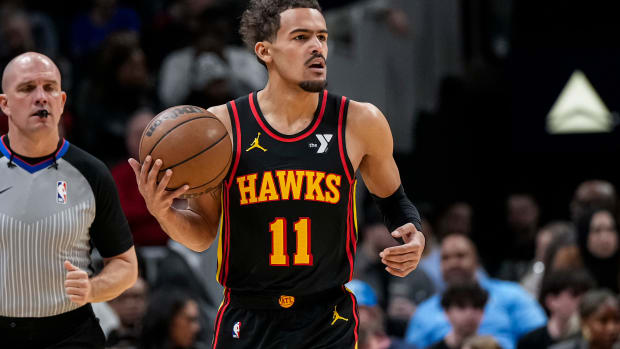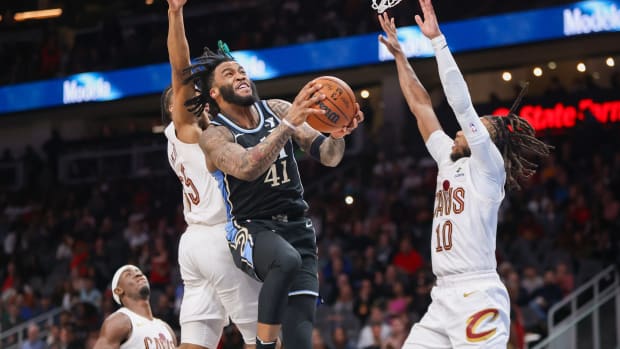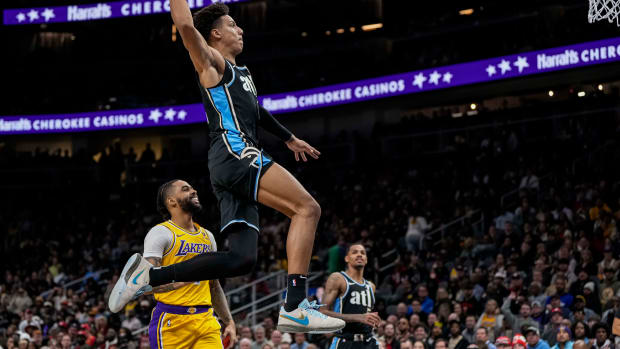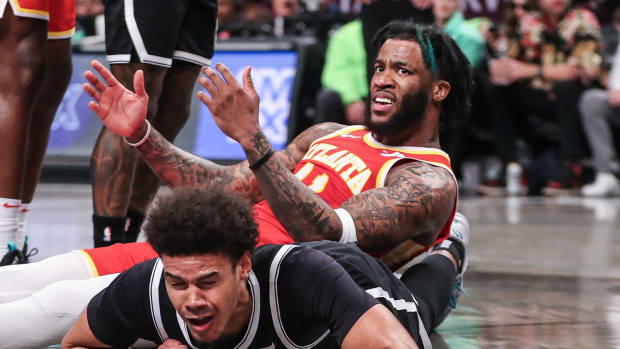Blowout Loss to Bucks Adds Insult to Injury
The crowd in State Farm Arena had long been deflated by the time Trae Young drove to the basket with 1:32 remaining in the second quarter of Friday night’s game. When he crumpled to the ground in pain with an apparent ankle injury, the building fell almost completely silent. Young tried to stand, but sunk back to the ground and called for teammates and trainers to help him off the floor. Already down 20 points to the Bucks, Atlanta’s chances of winning were swiftly dashed for good.
It’s hard to envision a worse situation for Atlanta to find itself in, having now lost nine games in a row – including 21 of its last 23 – and losing its best player in the midst of a blowout loss to a team without two of its four best players. To add insult to injury, Young was called for an offensive foul as he twisted his ankle. He’ll stay in Atlanta to receive treatment while the Hawks travel to Chicago, and while we don’t yet know the exact nature or severity the injury, it’s clear than any amount of time Young misses will leave the Hawks in dire straits.
Young’s absence – however long it is – will bring the flaws of Atlanta’s roster to the fore. The Hawks score at a below-average rate even with Young on the court, and plummet to catastrophic depths when he sits. They have mustered just 96.4 points per 100 possessions with their star off the floor – nearly eight points worse than Atlanta’s own league-worst offense. Friday night, the Hawks scored just over 0.8 points per possession. That’s partly an indication of Young’s value, but also a reflection of how little with which Atlanta has to work without him. This team had little shooting and playmaking to begin with; where will those elements come from with an All-World creator on the sideline? The Hawks weren’t built to sustain any injury to a central player – let alone their lone All-Star candidate.
“We’ll continue to explore ways to get the ball in Kevin [Huerter]’s hands, and Cam [Reddish]’s hands, and De’Andre Hunter’s hands,” Lloyd Pierce said. “Until [Young] is back, it’s still body and ball movement. How do we get the ball into those guys’ hands as well, but also facilitate and create shots for them? So Brandon [Goodwin] can help us there, but it won’t [be] his responsibility alone. We’ve got a lot of guys we need to step up and assume that role.”
Huerter and John Collins will provide some punch as they work their way back into a rhythm, but their value always worked on the premise that it would be ancillary to Young’s. Move more limited players into more central roles – and, by extension, even more limited players into complementary roles – and the entire operation slows down. What good are DeAndre’ Bembry’s assertive cuts and drives if the defense isn’t forced to mind other players? How effective is Huerter’s secondary pick-and-roll facilitation if it comes against a set defense rather than one already in motion. How much will Collins’ alleys to the rim shrink without a dynamic guard drawing his defender’s attention?
These, hopefully, aren’t questions the Hawks will have to worry about for long. While it appears unlikely that Young will play in Atlanta’s next two games (in Chicago and Orlando), there didn’t appear to be significant damage to his ankle on Friday and the Hawks will have three days off between games against the Magic and Celtics. But even with a healthy Young, the Hawks have issues he alone can’t solve. Atlanta never held a lead on Friday and was down 60-40 to a Milwaukee team without Giannis Antetokounmpo or Eric Bledsoe when Young sustained his injury. The Hawks offered slightly more resistance in the second half, but the Bucks had all the damage they needed to in the first half.
More than any strategic battle or gap in talent, habits decided this game. The Bucks know exactly who they are and what they do; even absent their two best creators, they still sliced Atlanta’s defense apart and bottled up its offense. They didn’t need the reigning NBA MVP to maintain the principles on which their system thrives. Milwaukee still moved the ball quickly, cut with purpose, and executed its gameplan. It didn’t matter that Antetokounmpo wasn’t playing; the Bucks needed only to slightly shift the focus of their offense.
The Hawks haven’t yet built that sort of structure or clarity of identity. Without its lone playmaker, Atlanta had nothing on which to fall back. It may not have had a singular force like Antetokounmpo to reckon with, but the Hawks’ defense still struggled to track shooters and cutters – a sign of poor communication and youthful neglect of finer details. “I thought we had, in the first half, a lot of confusion,” Pierce said. “Part of our coverage is to come together when we switch, and we were point-switching. That’s the disconnect that we had in the first half. I thought we did a better job, for the most part, in the second half of coming together with some of the switches.”
While Atlanta addressed some of its defensive mishaps in the second half – perhaps a product of Young not being on the floor – it never found answers on offense. The Hawks generated very few system buckets off of random movement or clever execution, due in equal measure to their own lack of direction on offense and Milwaukee’s unyielding defense. The Hawks, who generate the eight-highest share of shots at the rim in the NBA, attempted only 27 percent of their looks at the basket, where Brook and Robin Lopez constantly lurked to send away – and often entirely prevent – layups. Atlanta shot a measly 46 percent at the rim, and the former Lopez in particular had a Gobertian effect inside. “They were just trying to play cat-and-mouse and make me decide late,” Young said. “It kind of threw us off early, and obviously it carried over through the whole game.”
It's unclear where the Hawks go from here (other than to Chicago), in part because of Young’s injury and in part because of the team’s inconsistency. Despite Milwaukee’s advantages in experience and execution, Friday’s would have been a winnable game for Atlanta had it brought more fight and focus. With a back-to-back in Chicago looming and Young slated to miss perhaps multiple games, the Hawks will have a difficult time navigating their next six games – five of which are against playoff teams. It goes without saying that Atlanta desperately needs its point guard in the lineup, but this team has plenty more to worry about than the absence of a single player.




